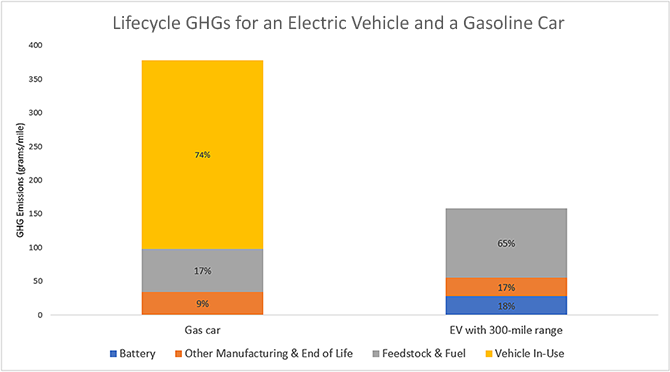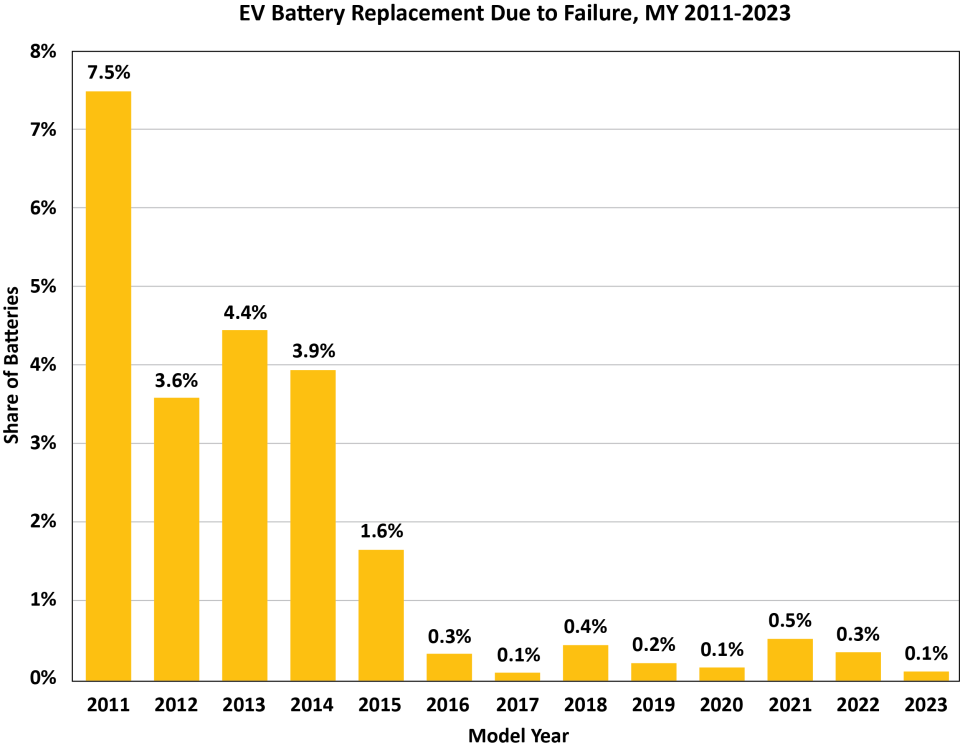Electric Vehicle Myths
E-Updates
- Myth #1: Electric vehicles are worse for the climate than gasoline cars because of power plant emissions.
- Myth #2: Electric vehicles are worse for the climate than gasoline cars because of battery manufacturing.
- Myth #3: Electric vehicle batteries are unreliable and need to be replaced every few years.
- Myth #4: The increase in electric vehicles entering the market will collapse the U.S. power grid.
- Myth #5: There is nowhere to charge.
- Myth #6: Electric vehicles don’t have enough range to handle daily travel demands.
- Myth #7: Electric vehicles are not as safe as comparable gasoline vehicles.
EV Facts
Myth #1: Electric vehicles are worse for the climate than gasoline cars because of power plant emissions.
FACT: Electric vehicles (EVs) typically have a smaller carbon footprint than gasoline cars, even when accounting for the electricity used for charging, plus they are far more efficient when it comes to energy use.
Electric vehicles (EVs) have no tailpipe emissions. Generating the electricity used to charge EVs, however, may create carbon pollution. The amount varies widely based on how local power is generated, e.g., using coal or natural gas, which emit carbon pollution, versus renewable resources like wind or solar, which do not. Even accounting for these electricity emissions, research shows that an EV is typically responsible for lower levels of greenhouse gases (GHGs) than an average new gasoline car. To the extent that more renewable energy sources like wind and solar are used to generate electricity, the total GHGs associated with EVs could be even lower. (In 2020, renewables became the second-most prevalent U.S. electricity source.1 ) Learn more about electricity production in your area by visiting EPA’s Power Profiler interactive web page. By simply inputting your zip code, you can find the energy mix in your region.
A significant advantage of EVs compared to conventional gasoline vehicles is their energy efficiency. EVs use approximately 87%–91% of the energy from the battery and regenerative braking to propel the vehicle. Gasoline vehicles only convert about 16–25% of the energy from gasoline into movement (averaging highway and city driving).2
EPA and Department of Energy's (DOE’s) Beyond Tailpipe Emissions Calculator can help you estimate the greenhouse gas emissions associated with charging and driving an EV or a plug-in hybrid electric vehicle (PHEV) where you live. You can select an EV or PHEV model and type in your zip code to see the CO2 emissions and how they stack up against those associated with a gasoline car.
Myth #2: Electric vehicles are worse for the climate than gasoline cars because of battery manufacturing.
FACT: The greenhouse gas emissions associated with an electric vehicle over its lifetime are typically lower than those from an average gasoline-powered vehicle, even when accounting for manufacturing.
Some studies have shown that making a typical EV can create more carbon pollution than making a gasoline car. This is because of the additional energy required to manufacture an EV’s battery. Still, over the lifetime of the vehicle, total GHG emissions associated with manufacturing, charging, and driving an EV are typically lower than the total GHGs associated with a gasoline car. That’s because EVs have zero tailpipe emissions and are typically responsible for significantly fewer GHGs during operation (see Myth 1 above).
For example, researchers at Argonne National Laboratory estimated emissions for both a gasoline car and an EV with a 300-mile electric range. In their estimates, while GHG emissions from EV manufacturing and end-of-life are higher (shown in orange below), total GHGs for the EV are still lower than those for the gasoline car.

Estimates shown3 from GREET 2 2021 are intended to be illustrative only. Estimates represent model year 2020. Emissions will vary based on assumptions about the specific vehicles being compared, EV battery size and chemistry, vehicle lifetimes, and the electricity grid used to recharge the EV, among other factors.
Above, the blue bar represents emissions associated with the battery. The orange bars encompass the rest of the vehicle manufacturing (e.g., extracting materials, manufacturing and assembling other parts, and vehicle assembly) and end-of-life (recycling or disposal). The gray bars represent upstream emissions associated with producing gasoline or electricity (U.S. mix), and the yellow bar shows tailpipe emissions during vehicle operations.
Recycling EV batteries can reduce the emissions associated with making an EV by reducing the need for new materials. While some challenges exist today, research is ongoing to improve the process and rate of EV battery recycling. For more information on EV battery development and recycling, visit:
- U.S. Department of Energy’s ReCell Center
- National Blueprint for Lithium Batteries, 2021-2030 (pdf) (1.6 MB, June 2021, report published by the Federal Consortium for Advanced Batteries)
Myth #3: Electric vehicle batteries are unreliable and need to be replaced every few years.
FACT: Electric vehicle battery replacements due to failures are uncommon.
Unlike starter batteries used in gasoline vehicles, electric vehicle drivetrain batteries are designed to last the lifetime of the vehicle and recent data shows they have very low failure rates. A recent study of about 15,000 vehicles from the earliest models through model year 2023 showed that electric vehicle battery replacements due to failure have been rare, at an average of 2.5%, outside of major recalls.4 Vehicle and battery technologies have improved since 2010, when modern EVs first entered the market, and since model year 2016 they have had less than a 0.5% failure rate. The majority of these batteries would have been covered as part of the manufacturer's warranty.

Note: Does not include EV battery recall replacements. Plug-in vehicles include all-electric and plug-in hybrid electric vehicles.
Batteries do tend to lose some of their initial range over time, but this study found that 97.5% of EVs are still using their original batteries (outside major recalls), and the replacement rate falls to under one percent for EVs made from 2016 onward. Current batteries and technologies have vastly improved since 2010, with expectations to improve performance and reliability while reducing impacts to the environment. Visit Department of Energy’s Vehicle Technologies Office to learn about the future of EV batteries.
Myth #4: The increase in electric vehicles entering the market will collapse the U.S. power grid.
FACT: Electric vehicles have charging strategies that can prevent overloading the grid, and, in some cases, support grid reliability.
It is true that the increasing number of electric vehicles on the road will lead to increased electricity demand. Yet, how that impacts the grid will depend on several factors, such as the power level and time of day when vehicles are charged, and the potential for vehicle-to-grid (V2G) charging 5 among others.
- EVs can be charged at off-peak times, such as overnight, when rates are often cheaper. Even with a mix of charging times (so not all nighttime charging), research indicates that sufficient capacity will exist to cover EVs entering the market in the coming years.6 And further down the road, when renewables make up a larger part of our energy mix in many regions, switching to more daytime charging (when some renewables like solar generate energy) with some energy storage capability should allow the grid to handle increases in EV charging.7 California leads the country with more than 1 million electric vehicles and EV charging currently makes up less than 1% of the state’s grid total load, even during peak hours.8
- EV charging consumed less electricity than water heating and air conditioning in a typical U.S. household in 2020, according to recent data released by the U.S. Energy Information Agency. 9
- Vehicle-to-grid (V2G) charging allows EVs to act as a power source that may help with grid reliability by pushing energy back to the grid from an EV battery. This is done by allowing EVs to charge when electricity demand is low and drawing on them when that demand is high.
Long term, higher electricity demand from EV growth may drive the need for upgrades to transmission and distribution infrastructure. Planning for this possibility is underway. The Department of Energy’s (DOE) Build a Better Grid Initiative, launched as part of the Bipartisan Infrastructure Law, will provide over $13 billion towards improving the reliability and efficiency of the grid over the next decade. Visit DOE’s Bipartisan Infrastructure Programs and search “grid infrastructure” to see where the initial investments will be made.
Myth #5: There is nowhere to charge.
FACT: Electric vehicles can be plugged into the same type of outlet as your toaster! When you need to charge while on the road, you’ll find over 72,000 stations and 196,000 EV charging ports in the U.S. available to the public.
Many people can meet their driving needs by plugging in only at home. Most EVs can be charged with a standard 120 Volt (Level 1) outlet. To charge the vehicle more quickly, you can install a dedicated 240 Volt (Level 2) outlet or charging system. And for those who live in apartments or condominiums, EV charging stations are becoming a more common building amenity.
Access to EV charging will increase significantly in the coming years as a result of government initiatives put in place as part of the Bipartisan Infrastructure Law, including an investment of up to $7.5 billion to build out a national network of electric vehicle chargers along highways, and in communities and neighborhoods. In February 2023, the White House announced major progress toward a made-in-America national network of EV chargers.
Interested in seeing how many chargers may be needed in your area? Use DOE’s EV Pro Lite Tool to get an estimate on charging needs in your state or metropolitan area as EV adoption grows.
For up-to-date information on EV charging locations, visit the Joint Office of Energy and Transportation’s Electric Vehicle Charging Stations map.
Myth #6: Electric vehicles don’t have enough range to handle daily travel demands.
FACT: Electric vehicle range is more than enough for typical daily use in the U.S.
EVs have sufficient range to cover a typical household’s daily travel. In 2022, according to the National Household Travel Survey, over 73% of all on-road passenger trips were 10 miles or less, and over 98% were less than 75 miles.10 Today, most EV models go above 200 miles on a fully-charged battery, with all new models rated for more than 100 miles on a single charge. And automakers have announced plans to release even more long-range models in the coming years.
Range estimates for specific EVs are available from the Find A Car tool — click on the car you are interested in, and check out the “EPA Fuel Economy” line in the table.
How you drive your vehicle and the driving conditions, including hot and cold weather, also affect the range of an EV; for instance, researchers found on average range could decrease about 40% due to cold temperatures and the use of heat.11
Myth #7: Electric vehicles are not as safe as comparable gasoline vehicles.
FACT: Electric vehicles must meet the same safety standards as conventional vehicles.
All light duty cars and trucks sold in the United States must meet the Federal Motor Vehicle Safety Standards. To meet these standards, vehicles must undergo an extensive, long-established testing process, regardless of whether the vehicle operates on gasoline or electricity. Separately, EV battery packs must meet their own testing standards. Moreover, EVs are designed with additional safety features that shut down the electrical system when they detect a collision or short circuit.
For more information, visit DOE’s Alternative Fuel Data Center.
1 U.S. Energy Information Administration (EIA): Renewables became the second-most prevalent U.S. electricity source in 2020. ↵
2 Electric vehicles (combined): Where the Energy Goes: Electric Cars. Gasoline vehicles (combined): Where the Energy Goes: Gasoline Vehicles ↵
3 Assumptions: EV with 300-mile range; vehicle lifetime of 173,151 miles for both EV and gas car; 30.7 MPG gas car; and U.S. average grid emissions. ↵
4Recurrent, New Study: How Long Do Electric Car Batteries Last?, Liz Najman, March 27, 2023. ↵
5 Department of Energy (DOE), Federal Energy Management Program, Bidirectional Charging and Electric Vehicles for Mobile Storage. ↵
6 U.S. Driving Research and Innovation for Vehicle Efficiency and Energy Sustainability (USDRIVE), Summary Report on EVs at Scale and the U.S. Electric Power System (pdf) (706 KB, November 2019); and DOE, Electric Vehicles at Scale – Phase I Analysis: High EV Adoption Impacts on the Western U.S. Power Grid (pdf) (15.3 MB, July 2020). ↵
7 Nature Energy, Charging infrastructure access and operation to reduce the grid impacts of deep electric vehicle adoption, September 22, 2022. ↵
8 E & E News: Renewable Energy, Why Electric Vehicles Won’t Break the Grid, September 19, 2022. ↵
9 U.S. Energy Information Administration, 2020 Residential Energy Consumption Survey, Detailed end-use consumption and expenditure estimates, Tables CE5.3a (pdf) (436 KB) & CE5.3b (pdf) (371 KB) June 2023. ↵
10 U.S. Department of Transportation, Federal Highway Administration, NextGen Origin-Destination Data Products, accessed June 28, 2024. ↵
11 AAA Electric Vehicle Range Testing Report (pdf) (7.3 MB, February 2019) ↵

